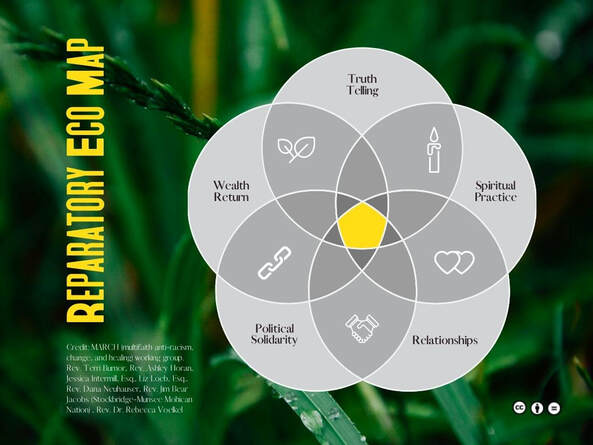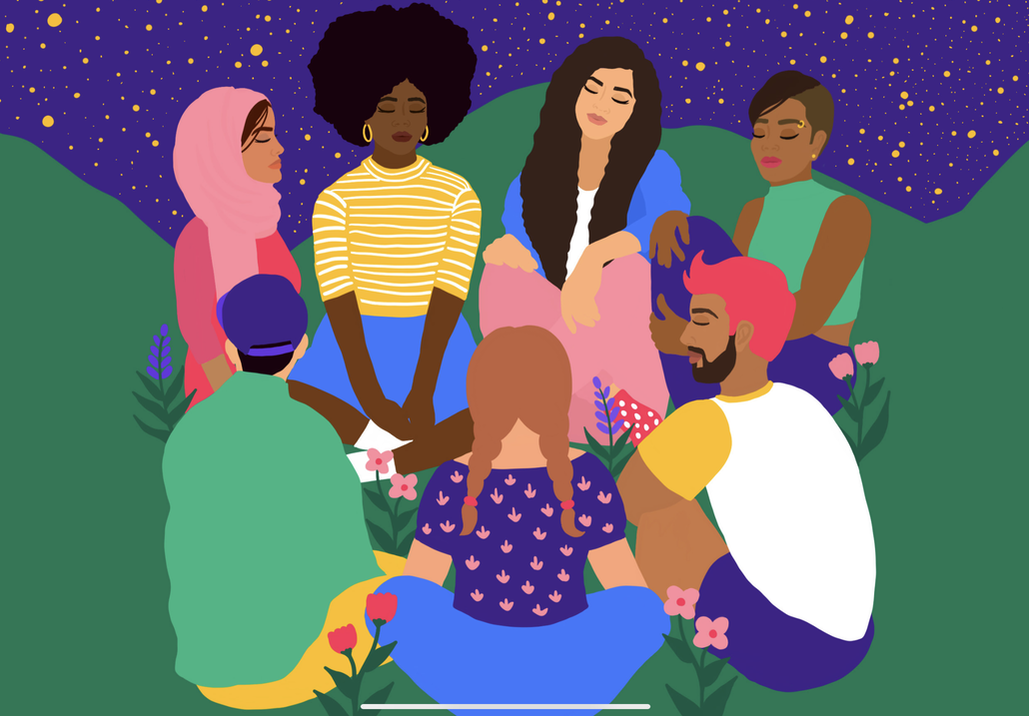|
Rebecca Gonzalez-Campoy, Beloved Community Communications Team Session three of Minnesota Interfaith Power and Light’s (MNIPL) Reparations Learning Table generated discussion and reflection around how our faith community traditions or spiritual practices determine how we engage in meaningful repair work for the long haul. Take a look at the MARCH/Multifaith Anti-Racism Change and Healing Eco Map as a visual reminder of our reparations journey. Reparatory Eco Map credit: MARCH (multifaith anti-racism, change, and healing) Rev. Terri Burnor; Rev. Ashley Horan; Jessica Intermill, Esq.; Liz Loeb, Esq.; Rev. Dana Neuhauser; Rev. Jim Bear Jacobs (Stockbridge-Munsee Mohican Nation, Rev. Dr. Rebecca Voekel Learning about atrocities that our faith traditions committed against people of color may motivate us to abandon those communities. Yet, they can be the very place in which we find strength and support to engage in what Reparations Learning Table co-leader Jessica Intermill calls “the repentance/repair/return framework.”
This notion of lament, then repair and return of ill-gotten gains with penalty payment included, is a theme found in many faith traditions. The Biblical story of Zacchaeus the tax collector and Jesus (Luke 19:1-10 New International Version) is one of several examples. Aparigraha in the practice of yoga is the concept that nonpossession of things grounds you in the universe. Zen Buddhism teaches the ethics of not taking what is not given. Many Indigenous nations live by the code, “take only what you need.” It’s by no means a new concept. We’re just returning to it. The 7th Principle of Unitarian Universalism calls us to respect “the interdependent web of all existence of which we are a part.” The proposed 8th principle currently under consideration by the Unitarian Universalist Association — “journeying toward spiritual wholeness by working to build a diverse multicultural Beloved Community by our actions that accountably dismantle racism and other oppressions in ourselves and our institutions” — could be a call to lament, repair, and return land and resources to our Black and Indigenous neighbors. What does this action look like? And why do the work as a faith community? MNIPL Reparations Table co-leader Liz Loeb lifted up these reasons:
This is intergenerational work: elders possess wisdom that, when combined with the energy and new ideas of younger people, can create a stronger faith community committed to the spiritual practice of reparations, however they are defined. Here’s a personal example. I have an adopted, now estranged, Ojibwe brother who many in the Two Harbors, Minnesota, public education and law enforcement systems deemed lesser than the white kids, while growing up. When some believed that he could succeed, he did, but many teachers expected nothing from him. And that’s what they got. My brother wound up in juvenile detention for minor offenses. When he got out, the local sheriff typically went after him first when a crime occurred. I’m currently pursuing a master’s in divinity in UU Social Justice and completing my Community Pastoral Education (CPE) unit with Volunteers of America High School. There I provide whatever support staff needs to help mostly students of color who’ve been bounced out of the mainstream Minneapolis Public School system. My fellow Social Justice CPE cohort meets at Stillwater State Prison because that’s where half of our group lives. We are each trying to make the lives better for those who, for whatever reason, veered off the path to a healthy life. We are trying to return what was taken from the ancestors of our clients. I work with kids who have family members in prison, who are from immigrant families struggling to make their way in a completely foreign country, who’ve already been to juvenile detention, and/or who are members of gangs. Some will graduate. Some won’t. I could not do any of this work as an individual. Getting involved in Unity’s social justice work led me to pursue a master’s in divinity in UU Social Justice so that I may work in community to repent, repair, and return that which was ill-gotten. As Dr. Maya Angelou said, “Do the best you can until you know better. Then, when you know better, do better!” I leave you with prompts for reflection: What traditions or practices help ground you when you think about reparations as a lifelong commitment? What insight does your faith tradition or community of practice hold that feels relevant to reparations? For more information about reparations work, please visit these online resources: Minnesota Interfaith Power and Light Reparation actions from around the country Amicus Volunteers of America The Justice Database, a project of Unity Church
0 Comments
Shelley Butler, Beloved Community Communications Team It was unusually cold that last Saturday in January 2023 when the Parish Hall filled up with people attending “Change, Conflict, and Complexity: Antidotes and Spiritual Practices,” an antiracism training/workshop led by Alfonso Wenker of Team Dynamics. If you have never heard Alfonso, watch for the next opportunity, as he is informative and wise, and frankly, he could read the phone book and make it sound compelling. As I looked around the room of eighty or so, I was impressed with the number of people whom I did not know or had never seen at a Team Dynamics event before, a sign of widening interest in antiracist multiculturalism at Unity Church? Also attending were many people I knew who typically attend these events, a sign of unwavering commitment to this work. There was energy in the room! The workshop focused on three parts: 1) comfort and certainty, 2) antidotes to white supremacy, and 3) archetypes in conflict. After each part, small groups met to discuss the ways in which we personally engaged with the topic. Complexity enters the equation as practice. Simply knowing the language, reading a book, or listening to a lecture on antiracism is not the same as practicing antiracism. There isn’t a set of instructions for social justice work, and neither is it finite. As much as we might want someone to just tell us what to do to fix the “oops” (the way that white supremacy treats racism), this work requires moving into practices that serve social/racial justice. These practices include less certainty and more questions, less focus on comfort and more on being present to the moment, less blame and more listening. Alfonso reminded us, “Discomfort is at the root of all growth and learning.” Our paired and small group discussions were exercises in discomfort as we were asked not only to examine our own behaviors and intentions but to share them. What is my relationship to certainty? What choices have I made to maintain my own comfort? In my racial justice work, when do I notice a pull to be right? What practices would I like to incorporate/give attention to in my spiritual and social justice work? What do I want to shed or release in my work? Uncharacteristically, I chose to join a small group of people that I did not know very well or at all. But as typically happens at Unity, we opened up with each other, exposed vulnerabilities, and supported each other’s point of view, even when it was negative or we didn’t agree. I left each group the better for the conversation, the points of view, and the sense of connection in community. Recognizing ourselves in the “Characteristics of White Supremacy” is typically a lesson in humility–we learn here the conscious and unconscious things we do that support white supremacy. But the lesson didn’t stop there. Carolyn Caswell remarked, “I really appreciated continuing the discussion about racial injustice and white supremacy, and this is the first time I’ve seen answers or solutions or antidotes to white supremacy.” Unity Trustee Mary Hernandez said, “What stuck out to me was the invitation to greet white supremacy where it shows up with antidotes. And to really work to reflect on those and try to weave them into the way that I walk in the world.” The third and last section of the program helped us understand the nature of conflict, and how to practice trusting, healthy conflict. Conflict is not necessarily bad and does not mean that something is broken. We were encouraged to think of conflict as “us against the problem,” instead of “us against them.” Come to a conflict with the understanding of shared purpose or interdependency, rather than believing there is only one solution or that your way is the right way. Be ready to listen to how others perceive the issue and explore possible solutions. These are more generative conflict practices. Kim Chapman offered this thoughtful reflection on the morning:
Notes:
Image Credit: From the cover of Turning Towards Each Other Workbook by Jovida Ross and Weyam Ghadbian; Illustration & Graphic Design by Shirien Damra. |
Topics
All
Beloved Community ResourcesUnity Justice Database
Team Dynamics House of Intersectionality Anti-Racism Resources in the Unity Libraries Collection Creative Writers of Color in Unity Libraries The History of Race Relations and Unity Church, 1850-2005 Archives
July 2024
Beloved Community Staff TeamThe Beloved Community Staff Team (BCST) strengthens and coordinates Unity’s antiracism and multicultural work, and provides opportunities for congregants and the church to grow into greater intercultural competency. We help the congregation ground itself in the understanding of antiracism and multiculturalism as a core part of faith formation. We support Unity’s efforts to expand our collective capacity to imagine and build the Beloved Community. Here, we share the stories of this journey — the struggles, the questions, and the collaborations — both at Unity and in the wider world.
The current members of the Beloved Community Staff Team include Rev. Kathleen Rolenz, Rev. KP Hong, Rev. Lara Cowtan, Drew Danielson, Laura Park, Lia Rivamonte and Angela Wilcox. |

